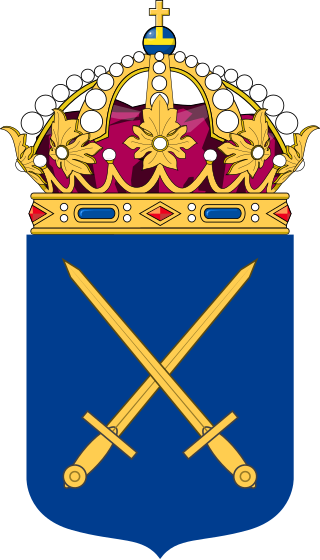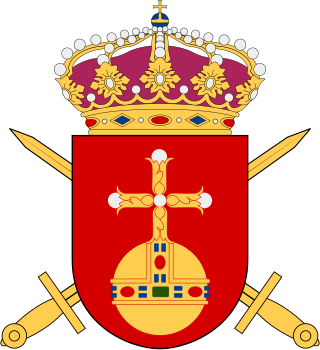
The 25 provinces of Sweden are historical, geographical and cultural regions. They have no administrative function, but retain their own cultural identities, dialects and folklore.

The Swedish Army is the land force of the Swedish Armed Forces. The army's history dates back to the Swedish War of Liberation in 1521.
Södermanlands storregemente or Landsregementet i Södermanland was one of the nine grand regiments organized by Gustavus Adolphus in the late 1610s and split into smaller regiments in the 1620s.
Östergötlands storregemente or Landsregementet i Östergötland was one of the nine grand regiments organized by Gustavus Adolphus in the late 1610s and split into smaller regiments in the 1620s.

The Västmanland Regiment, designations I 18 and Fo 48, was a Swedish Army infantry regiment that traced its origins back to the 16th century. It was disbanded for the first time in 1927 but later reraised and disbanded again in 1997. The regiment's soldiers were originally recruited from the province of Västmanland, and it was later garrisoned there.

The Uppland Regiment, designation I 8, was a Swedish Army infantry regiment that traced its origins back to the 16th century. It was disbanded in 1957. The regiment's soldiers were originally recruited from the province of Uppland, and it was later garrisoned there.
The Jönköping Regiment, designation I 12, was a Swedish Army infantry regiment that traced its origins back to the 16th century. It was merged with another unit to form a new regiment in 1927. The regiment's soldiers were originally recruited from Jönköping County, and it was later garrisoned there.
The Närke-Värmland Regiment was a Swedish Army infantry regiment that traced its origins back to the 16th century. It was split into two new regiments in 1812. The regiment's soldiers were recruited from the provinces of Närke and Värmland.

The Life Regiment Hussars is one of the world's oldest regiments still active. The regiment descends directly from units set up by King Gustav I of Sweden in 1536, when Sweden set up a draft of horses and men north and south of Stockholm. The regiment was very active in the 1600s and 1700s and helped win several key battles for Sweden on the European continent. Today, the regiment plays a central role in the Swedish Armed Forces and is the most active regiment in Swedish military international engagements.
In Sweden, a military district was a military subdivision and part of Sweden's military-territorial division. The military districts were established in 1833 and were, after several reorganizations, replaced by army divisions in 1893. In 1942, the military district were established who were multi-service commands of the Swedish Armed Forces. The military districts in the modern form were created in 1966, and each district was named according to the geographical district they covered. Several changes were made, such as creating or merging districts, until all military districts were disbanded in 2000. On 1 July 2000, the military districts were replaced by another military district organization, which was active until 31 December 2005.

The Halland Regiment, designations I 16 and I 16/Fo 31, was a Swedish Army infantry regiment that traced its origins back to the 16th century. The regiment's soldiers were originally recruited from the provinces of Västergötland and Dalsland, but it was later garrisoned in Halland. The unit was disbanded as a result of the disarmament policies set forward in the Defence Act of 2000.

The Södermanland Regiment, designated P 10 or P 3 and P 10/Fo 43, was an armored regiment of the Swedish Army with its roots in the 17th century, and was located in Strängnäs. The regiment was deactivated in 2004 and its assets were funneled into other parts of the military. Its life company was transferred to the Södermanland Group of the Home Guard, making the Södermanland Group the only Home Guard unit with such a company.

The Norrbotten Brigade, also NMekB 19, is a Swedish Army mechanized brigade located in the province of Norrbotten, active since 2022. It was previously active from 1949 to 2000. The brigade is located at Boden Garrison, Norrbotten Regiment in Boden.

Count Magnus Gabriel De la Gardie was a Swedish statesman and military man. He became a member of the Swedish Privy Council in 1647 and came to be the holder of three of the five offices counted as the Great Officers of the Realm, namely Lord High Treasurer, Lord High Chancellor and Lord High Steward. He also served as Governor-General in the Swedish dominion of Livonia.
The Defence Act of 2000 was a defence act passed by the Swedish Riksdag on 30 March 2000, and the largest reorganisation of the Swedish Armed Forces since the Defence Act of 1925. The act was a continuation of the policies set in motion by the Defence Act of 1996: shifting the military's focus from the defence of Swedish territory to a more flexible "operational defence* for smaller-scale peacekeeping operations in foreign nations. Many military formations were disbanded as a result.

Södermanland Regiment, designation I 10, was a Swedish Army infantry regiment that operated 1634–1942 and 1957–1963. The unit was based in the Strängnäs Garrison in Strängnäs, Södermanland, Sweden. In 1963 the regiment was transferred to the Swedish Armoured Troops under the name of Södermanland Regiment.










